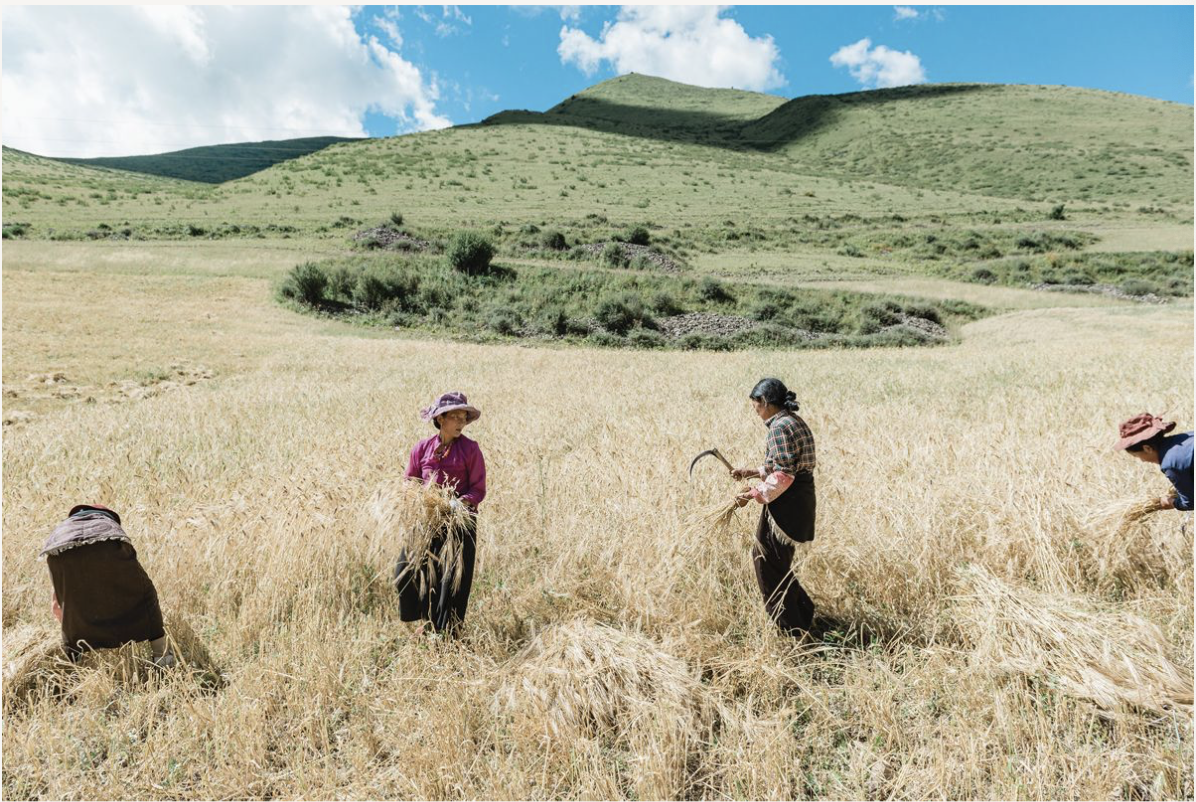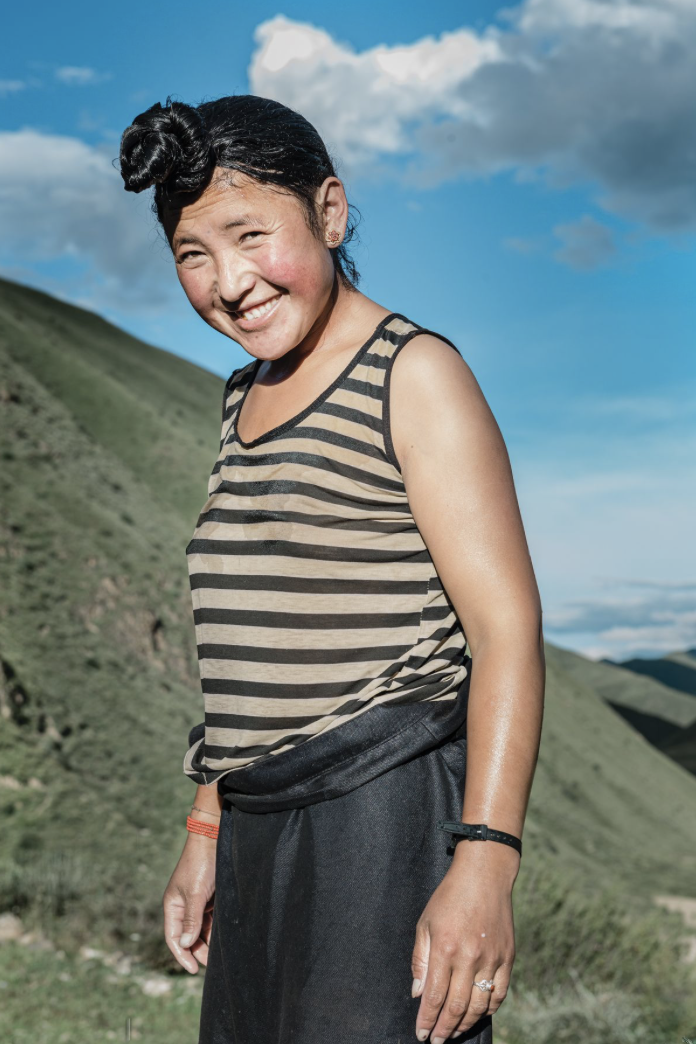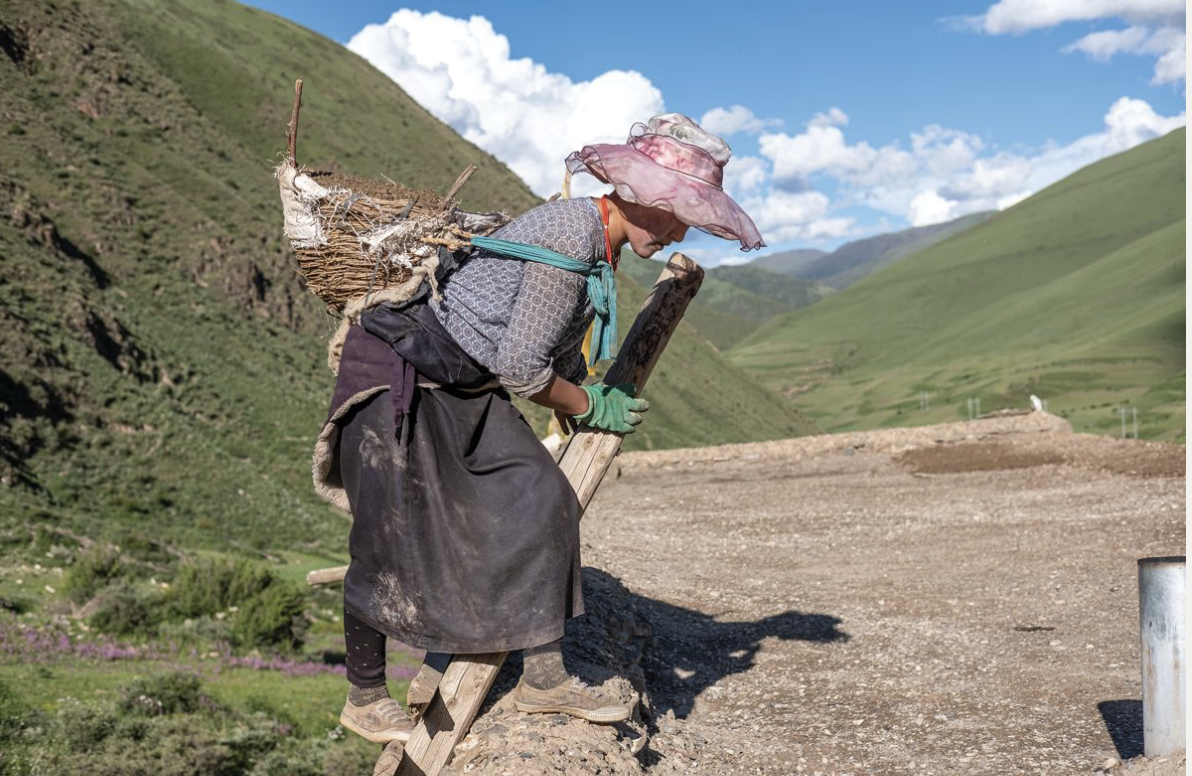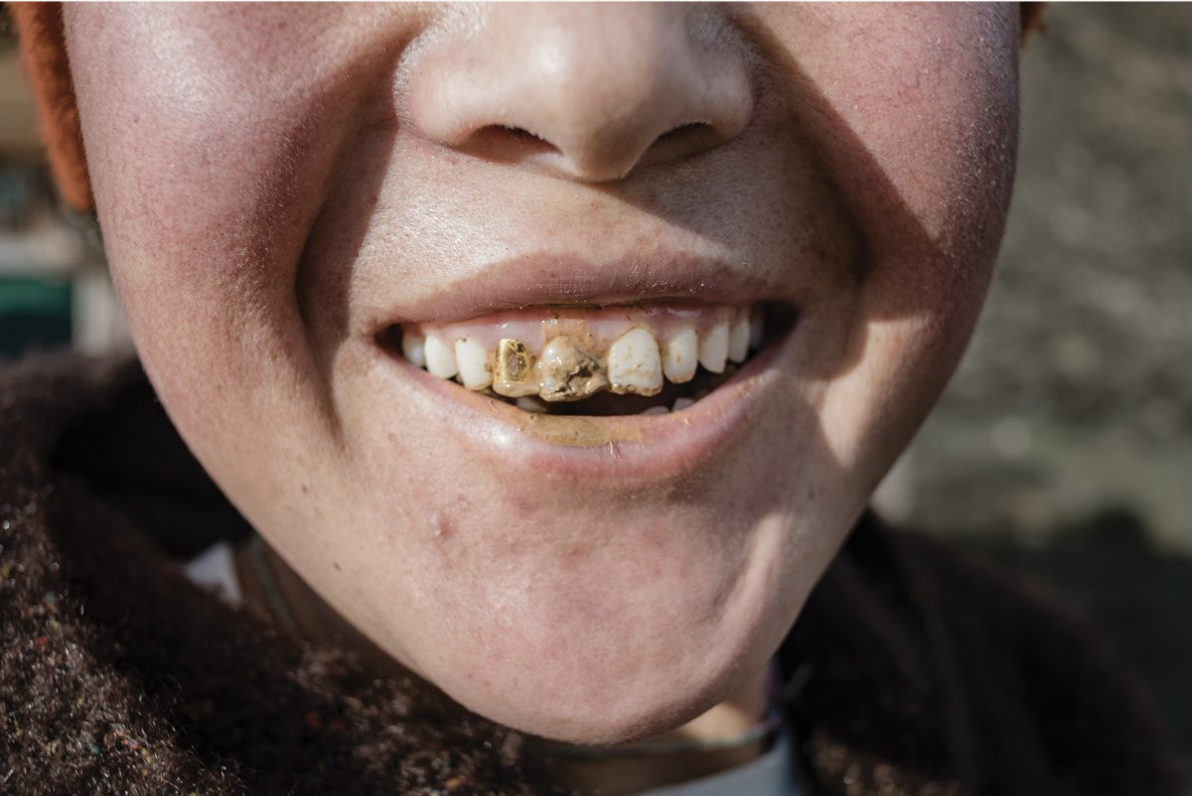High in the Tibetan mountains lives a young woman named Jamyang Tsomo. She leads a typical life for her region, filled with hard work and family responsibilities, as well as moments of joy. This is her story, and mine
WHEN YOU’RE RIDING your bike in Tibet, on some of the highest plateaus in the world, you feel free. It’s humbling. Cruising along those mountain-tops, you feel like you can pluck the clouds from the intense blue sky. And you can barely go a mile without a nomad insisting you come into their tent for a cup of tea with a dollop of yak butter. It’s a place where the people teach you about faith, love, compassion, and empathy. A place where women define womanhood as a sense of resilience, strength, and bravery.

Over the past decade I have made numerous trips alone, by bicycle, long-distance walking, trekking, and hitchhiking to document the culture of this region. It was on one of these trips, nearly nine years ago, that I came upon the village of Khana and a family that would change my life forever. I had stopped on the edge of town for lunch. Taking my camp stove and some instant noodles out of my pack, I prepared some food and began writing in my journal. Just then, a monk arrived on a motorcycle. With the few words of Mandarin that he could speak, he let me know he approved of me journaling. Then he continued up the hill. I later learned his name was Soma.
After lunch, as I began walking toward the mountain, I was greeted by two grandmother-aged Tibetan women seated upon freshly tilled soil. The eldest, with long gray hair braided on both sides of her head, waved me over. Her enthusiasm twinkled as bright as her smile with missing teeth. She was very insistent that I join her and her companion. They laughed while pantomiming the act of drinking tea. Then, raising a big bag of tsampa—a Tibetan food staple of ground barley, mixed with butter and tea—she offered me some.

Many Tibetan women in this region can’t understand Mandarin, so I used laughter, smiles, and hand gestures pointing up the mountain to explain that I had to go. That didn’t work. Eventually, I gave up the fight and plopped down next to the women. Their laughter continued and became louder as I was poured so much tsampa, it spilled onto my lap. After one cup of tea and an attempt to eat all that tsampa, hail and wind chased us into one of the women’s homes. A hailstorm in Tibetan culture means you aren’t meant to proceed because some revelation of sorts may be arriving. And, oh, did it!
The women and I climbed up a ladder from the lower level of the home, where the yaks and guard dog are housed. Pushing aside a thick cloth that was greasy from years of working hands, I entered the kitchen. It was the warmest room of the house, where the long black iron stove was located. We shook off the hail and sat. The woman of the house, the one with the long gray braids, was Gayla, and I soon learned she was the mother of Soma, the monk I had met earlier. The storm passed in less than an hour and the weather returned to blue skies and warmth.
That’s when another, younger woman arrived. Her name was Jamyang Tsomo, and she was Gayla’s daughter. I pantomimed with my hands and said in Mandarin that I needed to go. They kept telling me to “sit” in Mandarin, one of the few Mandarin words they knew, and then put their hands together in a prayer position while leaning their heads against the outside of one of their hands—the universal symbol for “sleep.” Obviously, they wanted me to stay.


Jamyang Tsomo knots up her hair after bathing in a stream that serves as her homestead’s primary water source
That afternoon, I helped Gayla and Jamyang Tsomo with their chores, such as washing the barley in the stream. At night, I slept in a room I shared with them that was used for storage and was always cold. The three of us lay down on separate hard beds, with Gayla curled up under old blankets and animal skins. I fell into an exhausted slumber, listening to Gayla and Jamyang Tsomo talk for hours. It brought back memories of my mother and I staying up late talking about anything and everything.
I shared the home with Gayla, her husband, and their four children: Iga, a boy my age; Soma, the monk; Tashi, who was in his early teens; and Jamyang Tsomo, who was in her late 20s and who was the only daughter in the household—until my arrival. Before I knew it, I felt like part of the family. They laughed as I tried to milk the yaks. I learned how to herd them out to pasture. I helped with laundry. Soon, Gayla and Jamyang Tsomo were giving me cooking tasks. Every morning I tried to leave, and Gayla’s eyes would fill up with tears. Surely I could stay just one more day.
Eventually, on the morning of the fourth day, I had to go. Gayla walked me down the road as I sucked down my grief and loss. When we arrived at the road, she turned around, and her face was soaking wet with tears. Hugging isn’t typical in Tibetan culture, but this tiny woman, with yak poo on her shirt from her morning chores, went in for the most maternal and comforting hug I have ever received on the plateau. My tears fell onto her shoulder, raining harder than the hailstorm that had put me there.

Snuggled in her bed after a long day of labor, Jamyang Tsomo spends her late-night hours playing games or speaking with her husband on a mobile phone
In 2016, I returned to the village. When I arrived, Jamyang Tsomo’s youngest brother, Tashi, exited the home, and there was no doubt he remembered who I was. I was greeted by the family as if they were my own. It seems we had all held on to the bond we had created two years earlier.
Jamyang Tsomo and I grew close on this trip, relying on funny noises and gestures to express ourselves. Since then, I’ve made multiple trips to this remote and often overlooked part of the country to tell her story— the story of a woman born into poverty who has matured into my vision of a modern-day warrior.
Jamyang Tsomo is unwed. It is rare for Tibetan women to remain unmarried past their early 20s. Her mother says it’s because “she doesn’t look good.” I watch as Jamyang Tsomo’s family treats her like an adolescent, constantly telling her what to do. But at the same time, she is the one caring for those same family members and meeting their daily needs, including cooking and laundry. Despite constant criticism and adversity, Jamyang Tsomo confronts every day with humor and strength.
During breaks from her daily chores, she makes jokes and may share a laugh that echoes through the mountains. The prankster and rebel of the family, she’d stick her tongue out after being reprimanded by her mother or brothers. Once, after finding her sister-in-law’s bra, she put it on while making ultrafeminine gestures you might see in a fashion advertisement.
A typical day begins before sunrise, when Jamyang Tsomo wakes to milk about a dozen yaks. They use the milk to make yogurt and cheese, and the cheese curds will be laid out on the mud-packed roof to dry and then are sold at local markets. Yaks are sacred in Tibetan culture and they provide dairy products, meat, fur, and skins.
As the first light of day peeks over the Himalayas, Jamyang Tsomo herds the yaks up the mountains protecting her village.
Returning home, she will mix fresh yak dung and dirt and dry the mix on the stone walls of the home. Once these patties are dry, they will be used in the home’s stove for heat and to cook. Many of her hours are spent doing laundry, washing dishes, and tending livestock. If the house is still, she might nap, but she’s often startled out of her slumber by a child needing something. Jamyang Tsomo won’t close her eyes until after midnight.
Late spring is the beginning of the season of nomadic life on the Tibetan Plateau. This is when Jamyang Tsomo mounts the family horse, without a saddle, and takes the yaks and horses into the mountains. The snow-covered peaks melt later in the summer, providing fresh grass for the yaks during the hotter months when the lowlands have dried and browned. She’ll live at a camp for months at a time, with an occasional visit back down to her family’s home. 
Jamyang Tsomo carries a handwoven basket filled with dirt up to the roof of her family’s home. After she has removed weeds and stones from the roof, she fills the dips and holes to prevent water leaks or collapse
The nomad camp is nestled among the peaks and is home to dozens of women. After sunrise and right before sunset, the area comes alive with the smell of campfires and milk. As a solo wom an traveler, being welcomed into a camp where all the women are smiling can make one feel like they have found their home, but the truth is, Tibetan women’s lives are always labor intensive. After the yaks are milked and sent to graze, the women spend the remaining hours of daylight on their hands and knees harvesting Tibetan fungus caterpillars—mummified moth larvae that have been taken over by a fungus that thrives at the high altitudes of the Himalayas. The dried worm is eventually sold as a valuable Chinese medicine.
Work is never-ending for most Tibetan women, but especially for Jamyang Tsomo. She is not only responsible for caring for her family, but also for bringing home an income to help them survive in one of the most challenging environments in the world. This is common for Tibetan women. The men who can read and speak Mandarin can be found selling goods and food at markets or going to bigger cities to open restaurants.
Summer is the season to harvest barley. This is when you’ll see countless women in the fields, bent over with a sickle in one hand while using their free hand to gather the dried grass. You can hear the singing for miles.
Blankets are stacked against the interior wall of the home for insulation 
During the 2017 barley harvest, Jamyang Tsomo fell off the back of a tractor and suffered a severe injury that removedenough skin to expose her skull. Without a hospital nearby, she had to travel for two days by car to the city of Chengdu toreceive an emergency skin graft on her forehead. Not only was she in pain and distressed at the time of her accident, butshe was also unable to communicate with her doctor, who spoke Mandarin. And her illiteracy prevented her from writing her name, so other Tibetan patients and visitors had to help her communicate.
Since her accident, Jamyang Tsomo keeps her head covered with a simple cloth and sometimes wears a wig. She also pays more attention to her hygiene and appearance. With the introduction of social media and access to TV, Jamyang Tsomo has become aware of what other women can do for themselves outside of village life.
Jamyang Tsomo’s life has returned to nearly normal since her accident, and she gave birth just a few months before COVID hit China. The father of her child is a truck driver who lives 100 miles away. Around midnight, after the family goesto bed, they talk on their cellphones for hours. Traditionally, Jamyang Tsomo would go to his village to live and raise their child. But an arrangement was made that Gayla seems quite pleased with, in which Jamyang Tsomo remains unwed and stays in the only home she has ever known. The household greatly benefits from this, and Jamyang Tsomo can share her parenting duties with her brothers while raising her own child.
Jamyang Tsomo’s story is far from over. For the last two years, I have been studying the Tibetan language with the hope of once again returning. Every woman on the Tibetan plateau has her own story and an individual voice full of strength, bravery, and love. Like Jamyang Tsomo, their stories prove that Tibetan women are some of the fiercest in the world.

Jamyang Tsomo smiles after taking a nibble of dried mud pinched from the walls of her family’s home. It’s not uncommon for Tibetans to enjoy the taste of mud. Fresh fruits and vegetables don’t grow at high altitudes; medical professionals believe a lack of vitamins and minerals triggers this craving
Top Image: All Images Photo Credit: Eleanor Moseman


